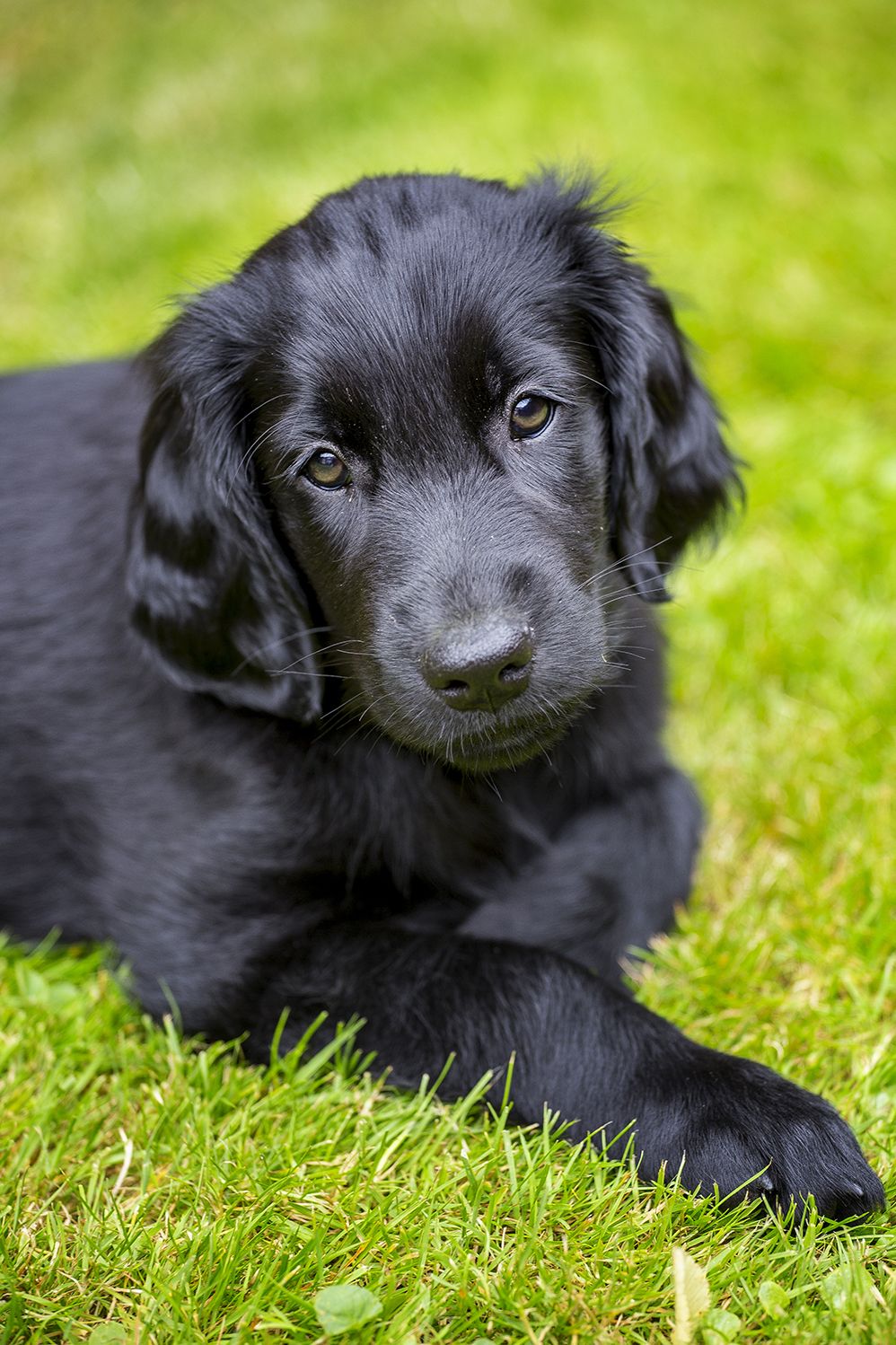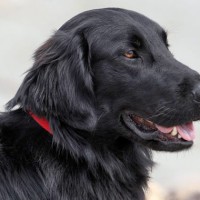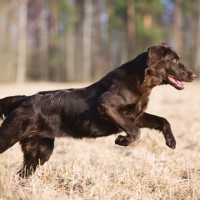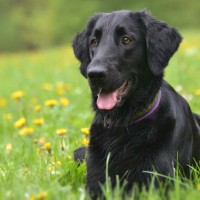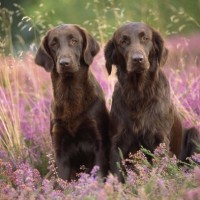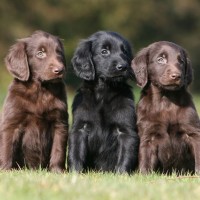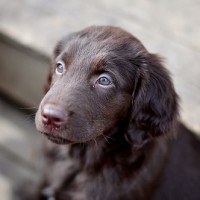Breed information
Group:
Sporting
Life span: 10-13 years
Height male: 56-58 cm/ 22-23 inches
Height female: 56-58 cm/ 22-23 inches
Weight male: 27-32 kg/ 60-70 pounds
Weight female: 27-32 kg/ 60-70 pounds
Character: Friendly, Confident, Devoted, Optimistic, Outgoing, Intelligent
History
Originating in the mid-19th century in England, the Flat-Coated Retriever gained popularity as a gamekeeper’s dog. Part of its ancestry is thought to have come from stock imported from North America from the now extinct St. John's water dog, but this is unverified. Canadian seafarers are thought to have brought Newfoundlands to British ports, and they factored into the ancestry of the Flat-Coated Retriever. Collie-type dogs may have been added to increase the breed's trainability along with the Newfoundland for strength and Setter blood for enhanced scenting ability. The first examples of the breed were introduced around 1860, but the final type was only established 20 years later.
After its introduction into the U.S., the Flat-Coated Retriever began to quickly gain in popularity as a gun dog, and from 1873 when the breed became a "stable type" according to the American Kennel Club until 1915 when it was officially recognised as a breed, their number grew rapidly. However, soon after, their popularity began to decrease, eclipsed by the Golden Retriever, which was actually bred in part from the Flat-Coated Retriever, along with other breeds. By the end of World War II, so few Flat-Coated Retrievers remained, the breed's survival was uncertain. However, beginning in the 1960s, careful breeding brought the population back and the breed gained in popularity again, for both the sport of conformation showing, and as a companion pet. Today, the Flat-Coated Retriever enjoys a modest popularity and is moving ahead as a breed through attentive breeding for the conformation, health, multipurpose talent, and exceptional temperament that are its hallmarks. It has yet to return in substantial numbers to field competition.
In 2011, 'Sh Ch. Vbos The Kentuckian' (aka Jet), a 9.5-year-old Flat-Coated Retriever from South Queensferry, near Edinburgh, Scotland, won Best in Show at Crufts. Almanza Far and Flyg (a.k.a. Simon), from Oslo, Norway, won the Gundog Group at Crufts in 2007. Before that in 2003, a Swedish dog 'Inkwells Named Shadow' had also won the Gundog Group. The last UK dog to win the Gundog Group at Crufts was "Sh Ch Gayplume Dream-maker" in 2002. The only other Flat-Coated Retriever to win Best in Show at Crufts was 'Ch. Shargleam Blackcap' in 1980. These wins have contributed to the breed's popularity in Europe and the United Kingdom.
Description
The distinctive and most important features of the Flat-Coat are the silhouette (both moving and standing), smooth effortless movement, head type, coat and character. In silhouette the Flat-Coat has a long, strong, clean, “one piece” head, which is unique to the breed. Free from exaggeration of stop or cheek, the head is set well into a moderately long neck which flows smoothly into well laid back shoulders. A level topline combined with a deep, long rib cage tapering to a moderate tuck-up create the impression of a blunted triangle. The brisket is well developed and the forechest forms a prominent prow. This utilitarian retriever is well balanced, strong, but elegant; never cobby, short legged or rangy. The coat is thick and flat lying, and the legs and tail are well feathered. A proud carriage, responsive attitude, waving tail and overall look of functional strength, quality, style and symmetry complete the picture of the typical Flat-Coat.
Health
Regular tests and clearances for hereditary joint conditions such as hip dysplasia, deafness, and eye conditions such as progressive retinal atrophy and glaucoma should be conducted by breeders on any dogs used for breeding. Occasionally, epilepsy is also seen in the breed. Flat-Coated Retrievers have a higher risk of cancer than most dogs. Hemangiosarcoma, fibrosarcoma, osteosarcoma, and malignant histiocytosis are particularly devastating, and occur at higher rates in them than in many other breeds. According to studies sponsored by the Flat-Coated Retriever Society of America (FCRSA), the average lifespan of the Flat-coated Retriever is only about eight years, with a high percentage of deaths due to cancer. More recent surveys in Denmark and the UK show a median lifespan around 10 years. A health survey of purebred dogs in the UK from 2010 showed approximately 50% of Flat Coated Retrievers death were due to some form of cancer.
Another more common affliction amongst Flat-Coated Retrievers is gastric dilatation and volvulus, otherwise known as bloat. This is not specific to Flat-Coats but it is common due to their large size and deep chests. If left untreated, the dog will die quickly. Gastric dilatation and volvulus is responsible for 5% of all Flat-Coated Retriever deaths and around 20% of non-tumour related deaths. Flat-Coated Retrievers have a very low rate of hip dysplasia and luxating patellas compared to other medium-sized breeds; the Orthopedic Foundation for Animals statistics consistently show a rate of hip dysplasia in the breed of less than 3%. In the 1997 FCRSA health survey, 4.2% of males and 3.2% of females had been diagnosed with luxating patellae.
Personality
The Flat-Coated Retriever is an eternal puppy, brimming with happiness and energy. They adore people and will greet everyone they meet as if that person were their best friend (which makes them lousy guard dogs). Flat-Coated Retrievers are excellent sporting dogs, and hunters can use them to hunt on land or in the water. After a day of hunting or playing with the kids in the back year, the Flat-Coated Retriever will turn into a lapdog – don't be surprised if you find him sleeping in bed under the covers. Though this breed is friendly and social and gets along well with other household pets, their extended puppyhood and constant energy can make them a challenge for first time dog owners.
Activity Requirements
Couch potatoes should steer clear of this active breed. Flat-Coated Retrievers have energy to spare, and just when you think you've tired your dog out, he's caught his second (or third, or fourth) wind. They tend to behave themselves indoors, but if your Retriever isn't getting his daily exercise requirement met, he'll let you know by promptly chewing valuable household items. Apartment dwellers should only adopt this breed if they can give him at least an hour to run every single day. Active families are best for the Flat-Coated Retriever, as they love to run and play. They'll walk, jog and hike and can keep up alongside a biker. Hunters enjoy this breed because they are so versatile – they are equally proficient on land as they are in water.
Trainability
The Flat-Coated Retriever looks like a dark colored Golden Retriever, but don't let the appearance fool you. Whereas Golden Retrievers are a dog trainer's dream, the Flat-Coated Retriever is a bit less reliable. They are prone to willfulness and love to test boundaries. Patience and an even temper is important when working with a Flat-Coated Retriever. Discipline will often backfire, so rewarding good behavior with affection and lots of treats is the only way to go.
Best Training Equipment Trainers Recommend
Behavioral Traits
Flat-Coated Retrievers have an extended puppyhood, and many individual dogs don't lose their puppy-like exuberance until they are well into adulthood. This means they basically never outgrow jumping and carrying on when someone enters your home. To keep his manners in check, it is important to train a Flat-Coated Retriever early on to obey “down” and “stay” commands. This breed, like his Retriever counterparts, has a tendency to be “mouthy.” If it fits in his mouth, he'll pick it up and run with it. They also have a tendency to mouth people's hands and sleeves. Giving your Flat-Coated Retriever enough of his own toys to chew on and teaching him to obey commands early on are important, as this can be very tough behavior to break in adulthood. Flat-Coated Retrievers often develop Separation Anxiety, which usually involves destructive chewing. They are a true family dog and can become depressed quickly if left alone for too long. People who work long hours shouldn't commit themselves to this breed. Families with a stay at home parent or those with flexible work schedules are much better suited. Proper exercise is also important to stave off anxiety.
Shedding
Weekly brushing will keep the Flat-Coated Retriever's coat shiny and healthy. They shed lightly through the year, and heavily twice per year. When the dog is shedding, brushing may need to occur two to three times per week. This breed only requires bathing as needed, when the dog has gotten into the muck, or when he starts to emit a doggie odor. Some owners prefer to clip the hair on the ears, feet, belly and tail for neatness sake. Check the ears weekly for signs of wax buildup, irritation, or infection. Cleanse the ears with a cotton ball and a veterinarian-approved solution - never use a cotton swab in a dog's ear canal. Brush the teeth once or twice per week to keep bad breath in check and prevent tartar buildup. Active dogs will wear down their nails naturally, but if the make a clicking sound on hard surfaces, it's time for a trim.
